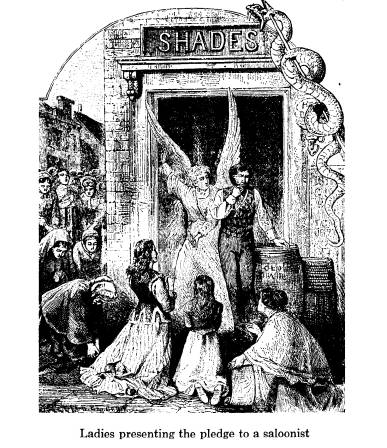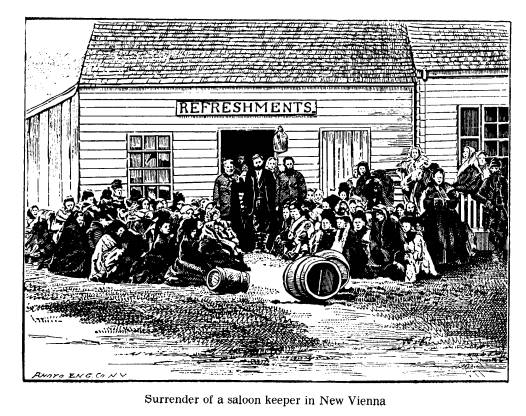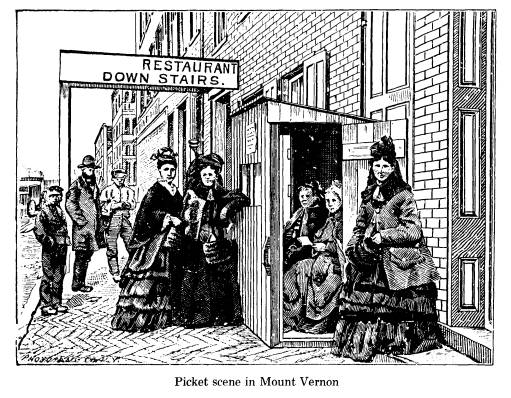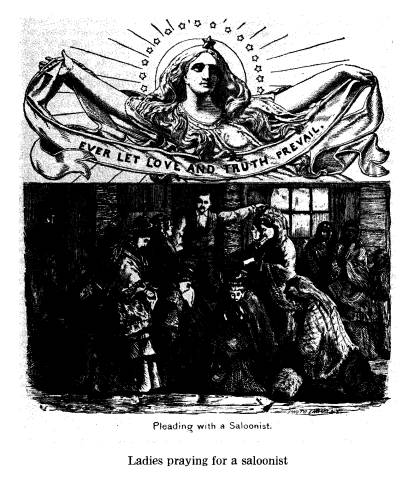Ohio History Journal
|
48 OHIO HISTORY |
|
|
|
THE WHISKEY WAR AT PADDY'S RUN: EXCERPTS FROM A DIARY OF ALBERT SHAW
edited by LLOYD J. GRAYBAR
In 1874 Albert Shaw, later the distinguished editor of the American Review of Reviews and friend of Presidents Theodore Roosevelt and Woodrow Wilson, was in his seventeenth year. An intelligent youth able to observe events with some discernment, he kept a diary of his life in the southwestern Ohio village of New London, better known as Paddy's Run.1 Renamed Shandon in 1893, this was a small, predominantly Welsh community at a Butler County crossroad ten miles from Hamilton and twenty-two from Cincinnati.2 The
NOTES ARE ON PAGES 72-74 |
THE WHISKEY WAR AT PADDY'S RUN 49
diary is of special interest because
some unusual events involving the neigh-
borhood's women were taking place.
Inspired by stories of the crusade
against alcoholism -- the "Women's
War on Whiskey" -- that was sweeping
much of Ohio, the ladies of Paddy's Run
were making their own drive against
the liquor traffic.
During the peak of this campaign in
February and March 1874, scores
of saloons in small towns of Ohio and
eastern Indiana were forced to close.
Most reopened within a year, in Paddy's
Run as elsewhere,3 but more than
ephemeral were the crusade's results,
which included the founding in Novem-
ber of the Woman's Christian Temperance
Union at Cleveland.
The women's battle against the saloon
began in December 1873 in Hills-
boro and Washington Court House, where
just before Christmas, Dr. Dio
Lewis of Boston, a popular lyceum
lecturer on health, exercise, temperance,
and other topics recounted how women of
his native Auburn, New York
had used prayer to halt the sale of
alcohol. Deeply impressed by this incidental
portion of his talk, women in both
places hastily organized to dry up their
communities. Results were speedy and
amazing. Within two weeks after
Lewis's appearance, not a saloon
remained open in Washington Court House.4
Relying on "moral suasion,"
without the damage made notorious later
by Carrie Nation, the ladies employed a
tactic comparable to current sit-ins,
lie-ins, and teach-ins. They staged
lengthy prayer meetings in the drink shops
and pestered the proprietors to sign a
pledge not to sell beer, wine, or whiskey.
Unless there was a hasty surrender, they
began daily picketing. Sometimes
they erected tabernacles in front of or
near the taverns. They wrote down the
names of thirsty patrons. To prayer were
added songs with special words
set to the tunes of "Onward
Christian Soldiers" and "The Battle Hymn of
the Republic." In Xenia, a teacher
stood her class of young girls outside
the swinging doors to chant "Say,
Mr. Barkeeper, has father been here?"
and "Father, Dear Father, Come
Home." Sometimes the zeal and persistence
of the ladies brought derision from
hostile habitues and verbal abuse from
saloonkeepers. On the other hand, some
repentant foes signaled their con-
version by pouring their intoxicating
stocks into the streets and even becom-
ing temperance exhorters themselves.5
A noisy celebration often followed
an especially satisfying victory. Since
the "best" community sentiment was
overwhelmingly on their side, the women
seldom encountered any effective
legal harassment, despite their
encroachment on property rights.6
In February 1874 the temperance drive
had reached several places in
Butler County.7 The ladies of
Paddy's Run, noting the progress in nearby
Oxford, determined in early March to dry
up their village. For more than a
month they picketed, prayed, and
petitioned until success was theirs.
For Albert Shaw the central figure was
his mother, Susan Fisher Shaw.
Born in Chester, Vermont in 1828 of an
old Yankee, Protestant family, she
had gone to Indiana to teach and there
in 1852 married Doctor Griffin M.
Shaw, a widower with two children. They
moved in 1854 to his home town,
Paddy's Run, where they had two
children, Mary in 1855 and Albert in 1857.
Doctor Shaw died there in 1863, leaving
a sufficient estate to care for the
|
50 OHIO HISTORY |
|
family.8 A devoted mother, but a woman of strong convictions, Susan Shaw taught Sunday school and though quiet of manner, joined the fight against drink. Albert recorded the doings of his mother and their friends in his diary.9 The sequence of entries relating to the crusade began on Monday, March 2, 1874. March 2. Jennie Jones who has been to Oxford for several days getting her teeth or jaw fixed gave us a very graphic account of the Woman's Tem- perance League in the place10 in prayer-meeting this evening. March 3. The whole county is rousing up against liquor-selling. March 4. Mr. [James A.] Clark, Mrs. [Hannah] Clark, Willie [Clark],11 Mother, Mary and I took dinner at Mrs. Jones's. March 5. Two loads of ladies went to Oxford to see the workings of the great "womans crusade" against liquor-selling. Mother and all the rest were enthusiastic. March 9. The ladies of this place met and organized a Temperance League12 to stop the sale of liquor here. They have over a hundred ladies on their list. March 10. In the afternoon the ladies had a prayer-meeting and this evening there was a temperance mass-meeting. Speeches from Clark, [George] |
|
THE WHISKEY WAR AT PADDY'S RUN 51 |
|
Candee,13 [Griffith] Morris,14 and Thomas F. Jones.15 Resolutions encourag- ing the ladies were adopted. March 11. The ladies had prayer-meeting this afternoon. March 12. Mother and Mrs. [Hugh] Williams16 visited all the saloons with a pledge but obtained no signers. The men treated them with respect. It will be a long hard job to stop the sale of liquor in this place. But the women are determined. March 13. Read a composition on Example. There was a general tem- perance prayer-meeting at 9 A.M. in the church and ladies' prayer-meeting in the afternoon. March 14. Temperance meetings today. I attended in the afternoon. Willie Clark was quite sick with croup in the evening and all night. March 15. Temperance meeting this evening. Mr. Candee made a tem- perance lecture in the evening. He sympathized with the saloonists in their sacrifice. Mr. Clark said the saloonist did not deserve sympathy. March 16. Rainy today. Went to Venice to temperance mass-meeting. Speeches from Bro. Hipes, Bro. Candee, Mr. Griff. Morris, Mrs. Morris, Rev. More [D. R. Moore].17 On the whole it was a dull meeting. March 17. John L. Evans18 signed a pledge that he will not sell liquor only for medicinal & mechanical purposes, so his case is disposed of. H. |
52 OHIO HISTORY
[Henry] H. Robinson19 has
promised on his honor to sell no more, but will
not sign a written pledge.
March 18. The ladies had meetings morning and afternoon. In the
after-
noon they visited Lawrence Brown
[Laurence Braun]20 and Lothland [John
Laughlin]21 in a mass of 35. Had prayers and
singing at both places. Left
pickets to notice who went in.
March 19. They commenced today to station pickets regularly at
both
Brown's and Laughlin's. William Scott of
N. Haven delivered a temperance
lecture in church. Lewis Deneret
[Demoret]22 and Mr. McKinstry gave
reports from Venice & Millville.
Just after dark some one scattered burlesque
programmes of the evening meeting.
March 20. The pickets, Mother among them, stayed out until 10
o'clock
P.M. Tom Williams and Lon. Passmore
signed the pledge. Peffer [Pfeffer]23
came four times during the evening for
beer.
March 21. Chopped down & cut up the old May cherry-tree in
front of
the side door. Played ball a while after
dinner. Saw the ladies holding meet-
ings on street. Mother was out as a
picket until nearly 12 P.M. George Patton,
John Irwin24 signed the
pledge.
March 22. Praise meeting in the evening. Mary played the organ.
March 24. The ladies are at it still.
March 25. Ladies had meetings morning and afternoon.
March 26. Mrs. Jones and Anna25 went to Cincinnati
this morning. Mother,
Carrie Davis,26 Mrs. David
Griffith,27 and Mrs. [Robert] Reese28 were on
picket at Laughlin's. They went in but
he ordered them out.
March 27. Mother and Mary went to Hamilton to settle up at the
Court
for Mother's guardianship. Laughlin was
taken sick this afternoon. He thought
Mother went to Hamilton to prosecute him
for putting them out. Mrs. J.
returned.
March 28. Mr. Clark and Mr. Morris and others are around trying
to get
indictments against the
saloon-keepers.29 Speakers from Millville addressed
the temperance meeting this evening.
March 30. The best news of the season is that Laughlin signed the
pledge
to sell no more liquor. The school and
church bells were rung the cannon was
fired and there was a general rejoicing.
Lorence Brown still holds out.
(The temperance fervor in Paddy's Run
speedily subsided after Laughlin's
capitulation. Presumably daily pressure
was kept on Braun for he yielded
less than a week after Laughlin. The
incident, however, seemed anticlimactic
and although Shaw kept up his diary
until April 28, he made only four
scattered entries about the Women's War
after the jubilant one of March 30.)
April 5. They have made an arrangement with Lawrence Brown by
which
he consents to quit selling on the 20th.
and has already quit everything but
beer. Two weeks of beer-selling and the
liquor business will be gone in Paddy.
April 6. The ladies are through with their street
prayer-meetings and
picketing. They will hold two meetings a
week for a while yet.
April 14. Mother & several other ladies went to a womans
temperance
|
THE WHISKEY WAR AT PADDY'S RUN 53 |
|
|
|
meeting at Venice this afternoon. The women are having a hard time with the saloonatics in Venice. April 24. I read a composition on "The Results of the Temperance Movement in this Place". Even before Shaw sounded his appropriate final note on the subject, the Cincinnati Enquirer, which had not thought much of the temperance crusade anyhow, bade goodbye to the campaign in Ohio editorially.30 By mid-May the dwindling amount of pertinent news on the campaign in the Cincinnati papers reflected a general decline of interest. Statistics, moreover, seemed to show that the women of Butler County had not really come very close to abolishing the liquor trade. Internal revenue receipts from liquor taxes remained substantially normal during March, and thereafter, as Philip Jordan pointed out, the sale and consumption of alcoholic beverages probably went underground until the temperance fervor abated.31 |
54 OHIO HISTORY
In any case, "normality"
returned to Paddy's Run within a year and some
of the old hands reopened their
businesses. By 1877 there was even need
for another local temperance campaign.32
Shaw, who with his mother and
sister Mary was then living in Grinnell,
Iowa, where he was attending college,
was skeptical of a new crusade's chances
for success, noting wryly: "My
faith is not the strongest. I'm afraid
the results will not be permanent. We
can only thank the Lord, and
wait."33 His assessment proved correct,34 but
despite the community's failure to
become permanently dry then, the whiskey
war at Paddy's Run remains an intriguing
and colorful example of a significant
movement in Ohio's social history.
THE EDITOR: Lloyd J. Graybar is As-
sistant Professor of American History at
Eastern Kentucky University and the au-
thor of "Albert Shaw's Ohio
Youth," which
appeared in the Winter 1965 issue of Ohio
History.
72 OHIO
HISTORY
the economic system of cattle feeding in
the Scioto Valley.
25. Renick, Memoirs, 3-4, 32-35,
48; Henlein, Cattle Kingdom in the Ohio Valley, 131;
Bennett, The County of Ross, 137; The Scioto
Gazette, March 27, June 26, 1806; January
11, 1808.
26. This event was noted in the Scioto
Gazette, February 24, 1820.
27. Bennett, The County of Ross, 359;
Jonathan G. Harness to Daniel McNeill,
November 1, 1820. McNeill Family Papers.
28. Renick, Memoirs, 55.
29. Henlein, ed., "Journal of F.
and W. Renick," 174, 176.
30. King, "The Coming and Going of
Ohio Droving," 251.
31. George W. Renick.
32. Daniel McNeill to Daniel R. McNeill,
April 11, 1827. McNeill Family Papers.
33. Catherine McNeill acted as her
ailing father's amanuensis in this letter. Daniel
McNeill to Daniel R. McNeill, March 31,
1829. McNeill Family Papers.
34. Strawder McNeill was the son of
Daniel McNeill's brother, John, who had
migrated to Ross County in 1809. In 1816
he established the town of Frankfort upon his
lands in Concord Township. Throughout
his life, John McNeill was engaged in the
mercantile and livestock businesses.
Will of Daniel McNeill, Sr., Will Book I, Office of
the Clerk of the County Court of Hardy
County, 328; Bennett, The County of Ross, 599;
Williams Bros., History of Ross and
Highland Counties, 314.
35. Catherine McNeill to Daniel R.
McNeill, March 15, 1830. McNeill Family Papers.
36. Inventory of the Estate of Daniel
McNeill, Will Book 6, Office of the Clerk of the
County Court of Hardy County, 71-74.
37. John Ashton, "History of
Shorthorns in Missouri prior to the Civil War," Missouri
State Board of Agriculture Monthly Bulletin,
XXI (November 1923), 14-29.
38. Henlein, Cattle Kingdom in the
Ohio Valley, 75-79; Sanders, Shorthorn Cattle,
185-186; Charles S. Plumb, "Felix
Renick, Pioneer," Ohio Archaeological and Historical
Quarterly, XXIII (January 1924), 28-56; Edward N. Wentworth, A
Biographical Catalog
of the Portrait Gallery of the Saddle
and Sirloin Club (Chicago, 1920),
235-238.
39. For names of settlers from the South
Branch who went to Missouri, see Ashton,
"History of Shorthorns in
Missouri," 59-62.
THE WHISKEY WAR AT
PADDY'S RUN:
EXCERPTS FROM A
DIARY OF ALBERT SHAW
The editor, Lloyd J. Graybar, wishes to
dedicate this article to the memory of his
mother, Maude V. Graybar.
1. Lloyd J. Graybar, "Albert Shaw's
Ohio Youth," Ohio History, LXXIV (1965), 29-34,
tells of Shaw's upbringing in Ohio and
his later rise to prominence. The diary is deposited
in the large collection of Shaw
Manuscripts in the New York Public Library. His capi-
talization, spelling and punctuation
appear here as in the original.
2. Ibid., 31. For history of the
community see Stephen Riggs Williams, The Saga of the
Paddy's Run (Oxford, Ohio, 1945). W. H. Irwin, Esq., and Rev. S. D.
Crothers, Cen-
tennial Historical Sketches of
Greenfield and Vicinity, July 4, 1876 (Greenfield,
Ohio,
1876), contains "An Historical
Sketch of Paddy's Run, Butler County, Ohio," by Rev.
B. W. Chidlaw [n.p.].
3. J. H. Beadle, The Women's War on
Whiskey: Its History, Theory, and Prospects
(Cincinnati, 1874), is a graphic account
of the crusade written by an experienced reporter
for the Cincinnati Commercial. From
January 23 until May 2, 1874 he visited a score
of Ohio towns to write on the campaign's
progress and later published his stories in his
book. See also Cincinnati Commercial,
January 6, 16, February 8, 10, April 10, 1874;
Cincinnati Daily Gazette, February
16, 1874; Cincinnati Enquirer, March 6, 1874; Mary
Earhart, Frances Willard: From
Prayers to Politics (Chicago, 1944), 138, 141-145. The
Commercial, edited by Murat Halstead, native of Paddy's Run, gave
extensive news
coverage to the crusade, often on the
first page, under a standing headline: "Woman's
War on Whiskey" until March 30 when
"Temperance" was substituted. Editorially it
was unenthusiastic. The Gazette made
a lesser effort at coverage, calling it "The Woman's
Temperance Crusade" or "The
Temperance Crusade." The disapproving Enquirer gave
considerable space to news under
headings "Woman's War" or "The Crusade."
4. Cincinnati Daily Gazette, February
3, 1874; Beadle, Women's War, v, 11-14. Dr.
Lewis wrote the foreword to Beadle's
book in March 1874.
5. A notable example was John C. Van
Pelt, New Vienna saloonkeeper who first
threw beer on his female tormentors,
then repented, dumped his stocks and joined Dr.
Lewis when he returned to Ohio in
February on another lecture tour to advance the
NOTES
73
cause. An example of the pledge used is
found in Beadle, Women's War, 109. Typical
of the temperance songs, often printed
in the newspapers, was Mrs. Emily J. Bugbee's
"Battle Hymn of the Crusade,"
quoted by Beadle, Women's War, 112-113:
On the plains of bloodless battle, they
are gathering true and strong,
All the hero-hearted women, who have
wept in silence long,
At the terrible oncoming of this
raven-winged wrong.
Now God is leading on.
Chorus -- Glory, glory, hallelujah, etc.
6. Cincinnati Commercial, February
3, 5, 19, March 7, 1874; Cincinnati Enquirer,
March 6, 1874; Beadle, Women's War, 22-40,
69-77; Earhart, Frances Willard, 138, 141-
150.
7. Cincinnati Commercial, February
18, 19, March 24, 1874; Cincinnati Daily Gazette,
March 23, 1874.
8. Graybar, "Shaw's Ohio
Youth," 30-32.
9. To identify places and persons
mentioned in the diary, several books, the Hamilton
Telegraph, the suburban columns of the Cincinnati papers, and the
section of the Shaw
letter collection pertaining to his Ohio
friends have been consulted. Assistance also has
been generously given by Mr. Albert
Shaw, Jr., of Ardsley, N. Y., and Mrs. Henry
Robinson of Shandon, Ohio. Volumes used
were: Bert S. Bartlow and others, eds.,
Centennial History of Butler County,
Ohio (n.p., 1905); Hazel Stroup, Butler
County,
Ohio, Cemetery Records (Cincinnati, 1963); Philip Fisher, The Fisher
Genealogy: Record
of the Descendants of Joshua, Anthony
and Cornelius Fisher of Dedham, Massachusetts,
1636-1640 (Everett, Mass., 1898); William Leon Halstead, The
Story of the Halsteads of
the United States (Ann Arbor, Mich., 1934); Memorial Record of Butler
County, Ohio
(Chicago, 1894); Albert Shaw, "The
Ohio Manuscript" (unpublished autobiography,
1941); Western Biographical Publishing
Company, pub., A History and Biographical
Cyclopaedia of Butler County, Ohio (Cincinnati, 1882); and Williams, Saga of the
Paddy's Run. Because of the duplication of family names it has been
impossible to
identify everyone.
10. The crusade had begun in Oxford, in
the northern portion of Butler County, on
January 31. The last saloon there closed
on March 23. Cincinnati Daily Gazette, February
16, 1874; Cincinnati Commercial, March
24, 1874.
11. James A. Clark was appointed
principal of the graded school in 1872. He was
married to the former Hannah Williams,
and Willie was their young son. Cemetery
Records, IV, 28; Williams, Saga of the Paddy's Run, 128,
190; Anne Peate to Shaw,
June 1, 1876, Shaw Manuscripts.
12. The Woman's Temperance League was
not permanently organized until May.
Susan Shaw was chosen a director.
Hamilton Telegraph May 28, 1874.
13. George Candee was pastor of the
Congregational Church from 1872 to 1875. Wil-
liams, Saga of the Paddy's Run, 125.
14. Griffith Morris, whose wife Mary
Jane became president of the Temperance
League, was a prominent farmer and a
member of the school board. Hamilton Telegraph,
May 28, 1874; Shaw, "Ohio
Manuscript," chap. 11, p.29; Williams, Saga of the Paddy's
Run, 128, 159, 185.
15. Thomas F. Jones was clerk of the
Congregational Church from 1849 to 1871 and
also one of the three acting deacons.
Williams, Saga of the Paddy's Run, 183, 185.
16. Mrs. Hugh Williams was the widow of
a prominent blacksmith and church deacon.
Shaw, "Ohio Manuscript," chap.
8, p.4; Williams, Saga of the Paddy's Run, 127, 183, 184.
17. Probably David R. Moore,
pastor-elect of the Presbyterian church in Venice in
nearby Ross Township. Cincinnati Gazette,
March 18, 1874.
18. John L. Evans, a storekeeper, was
postmaster twice, in 1852-53 and 1861-71.
Williams, Saga of the Paddy's Run, 88,
100.
19. Henry Hidlay Robinson owned a
three-story hotel and store building. Williams,
Saga of the Paddy's Run, 148-149.
20. Perhaps Shaw meant Laurence Braun,
who like the Scheels, Pfeffers and Sonnen-
tags, belonged to one of the community's
German Catholic families. Williams, Saga of
the Paddy's Run, 119.
21. This was the only reference to a
Lothland, which leads to the surmise that Shaw
really meant John Laughlin. Mrs. Henry
Robinson to author, January 25, 1966.
22. Lewis Demoret later became editor of
the weekly Venice Graphic. Mrs. Henry
Robinson to author, January 25, 1966.
23. Perhaps Shaw meant either Benedict
or Henry Pfeffer. Nothing is known of
either's age or occupation. Anne Peate
to Shaw, August 31, 1877, Shaw Manuscripts;
Williams, Saga of the Paddy's Run, 119.
24. John Irwin, Sr., was in 1877 a
member of the Paddy's Run Horse Protection
Company. Mrs. Henry Robinson to author,
January 25, 1966.
25. Anna B. Jones, born in 1862, later
taught for three years in Lima, Ohio and then
for forty years in missionary schools in
and around Constantinople, Turkey. It is not
known to which of the several Jones
families she belonged. Cemetery Records, IV, 37;
Williams, Saga of the Paddy's Run, 91.
74 OHIO
HISTORY
26. Perhaps Mrs. Caroline J. Davis, nee
Jones. Cemetery Records, IV, 56.
27. The wife of carpenter David
Griffith. Williams, Saga of the Paddy's Run, 67.
28. The wife of Robert Reese, an acting
deacon of the Congregational Church. Wil-
liams, Saga of the Paddy's Run, 183.
29. Legal means were seldom taken
against saloonkeepers, but under the Adair Law,
an Ohio statute in effect before the crusade began, relatives
could bring charges if liquor
were sold to their husband or father,
and interested citizens could act to stop the sale
of whiskey to chronic drunkards. Beadle, Women's
War, 16-18, 95-104.
30. Cincinnati Enquirer, April
13, 1874. This was a bit premature since some cam-
paigns continued into May. See also
Philip D. Jordan, Ohio Comes of Age, 1873-1900
(Carl Wittke, ed., History of the
State of Ohio, Columbus, 1943), V, 35.
31. Jordan, Ohio Comes of Age, 35.
32. Orsini Scheel to Shaw, July 28,
1877; Anne Peate to Shaw, August 31, 1877, Shaw
Manuscripts; Shaw, "Ohio
Manuscript," chap, 8, p.45.
33. Shaw to Anna Jones, October 12,
1877. Shaw Manuscripts.
34. Anne Peate to Shaw, October 31,
1878. Shaw Manuscripts.



